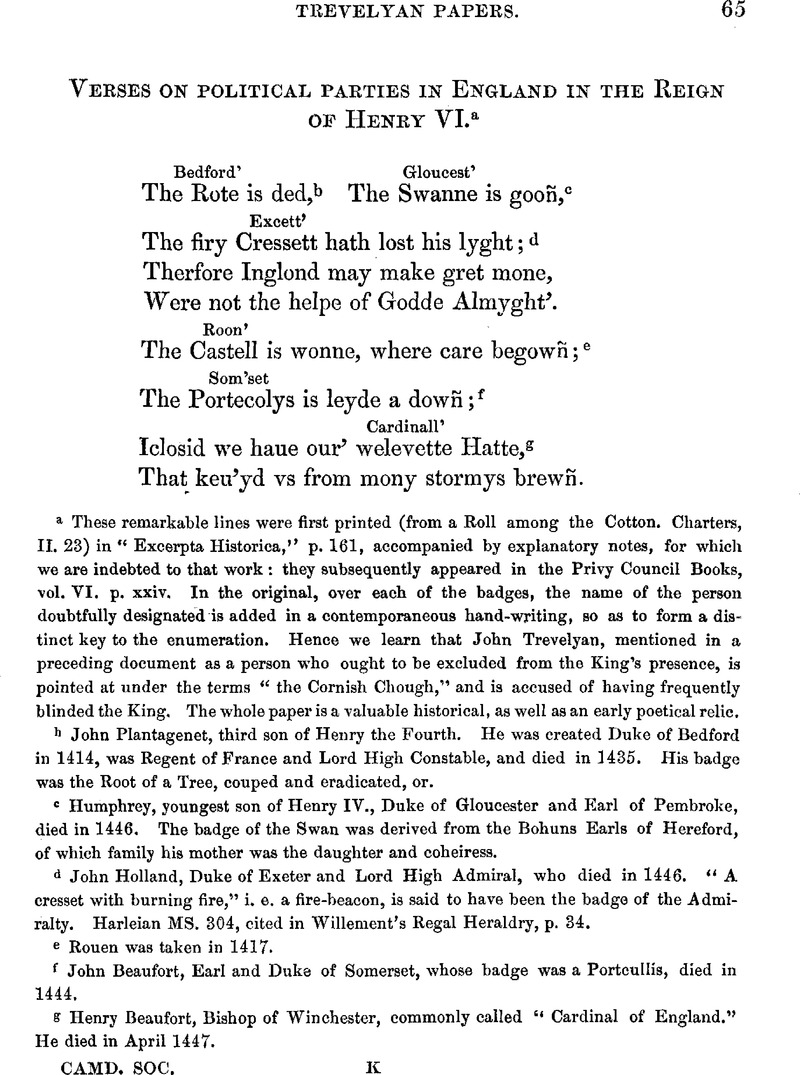No CrossRef data available.
Published online by Cambridge University Press: 23 February 2010

b John Plantagenet, third son of Henry the Fourth. He was created Duke of Bedford in 1414, was Regent of France and Lord High Constable, and died in 1435. His badge was the Root of a Tree, couped and eradicated, or.
c Humphrey, youngest son of Henry IV., Duke of Gloucester and Earl of Pembroke, died in 1446. The badge of the Swan was derived from the Bohuns Earls of Hereford, of which family his mother was the daughter and coheiress.
d John Holland, Duke of Exeter and Lord High Admiral, who died in 1446. “A cresset with burning fire,” i. e. a fire-beacon, is said to have been the badge of the Admiralty. Harleian MS. 304, cited in Willement's Regal Heraldry, p. 34.
e Rouen was taken in 1417.
f John Beaufort, Earl and Duke of Somerset, whose badge was a Portcullis, died in 1444.
g Henry Beaufort, Bishop of Winchester, commonly called “Cardinal of England.” He died in April 1447.
h John Mowbray, third Duke of Norfolk, K.G. He succeeded in 1432, and died in 1461. A White Lion is one of the badges of the house of Mowbray.
i William de la Pole, Earl and Marquess, and in 1448 Duke of Suffolk, Lord Chancellor, and Lord High Admiral. In Ashmole's MS. No. 1121, this badge is attributed to the Duke of Suffolk, the clog argent and the chain or.
k John Lord Talbot and Furnival, created Earl of Shrewsbury in 1442.
l William Nevill, Lord Fauconberg jure uxoris. He was created Earl of Kent in 1461, and died in 1463. Among other notices of crests of Knights in the Lansdowne MS. 870, is “Wyllyam Faulconbrydge,” probably a mistake for Fauconberg, “the fysshe hoke.”
m Robert Lord Willoughby of Eresby, who succeeded to that barony in 1409 ; died in 1452. His badge of the “Mill Sail,” or rather mill-rind, was derived from his ancestors, the Beks of Eresby, whose arms were, Gules, a mill-rind argent.
n Richard Neville the King Maker. Having married Ann, sister and heiress of Henry Beauchamp, Earl of Warwick, he was created Earl of Warwick 1449.
o Humphrey Earl of Stafford, who was created Duke of Buckingham in September, 1441, and died in 1459. A Cart-wheel is the badge of Stafford, and is generally represented with flames issuant from the ends. In the stained glass of Nettleshed church, in Kent, it is surrounded by a cord folded in the form of Stafford knots or. This badge was among those which were sculptured on the castle of Maxstoke, in Warwickshire, by order of Humphrey Stafford, Duke of Buckingham.
p Thomas Daniel, Esquire of the King's body. He appears to have been an adherent of the Duke of Suffolk ; and is frequently noticed on the Rolls of Parliament.
q Norreys. Probably the John Norreys, Esquire of the King's body, who is often mentioned as a feoffee of the King's lands on the Rolls of Parliament in the reign of Henry the Sixth, and in that monarch's will.
r John Trevelyan, Esquire. He was a member of the ancient family of that name in Cornwall, ancestors of the present baronet, and appears to have used a Cornish chough as his badge.
s “Rex,” King Henry the Sixth.
t William Fitz-Alan, who succeeded to the earldom of Arundel in 1437, and died in 1487. The white hard was perhaps an error for the white horse, the well-known badge of the Fitz-Alans Earls of Arundel.
u Henry Lord Bourehier, and Earl of Ewe in Normandy; succeeded to that barony in 1435, was created Viscount Bourehier 1446, and Earl of Essex 1461.
x Query, Edmund Lacy, who was Bishop of Exeter from 1420 to 1455 ?
y Thomas Courtenay, fifth Earl of Devonshire, who succeeded to that dignity in 1422, and died in 1458.
z Richard Plantagenet, Duke of York, father of King Edward the Fourth.